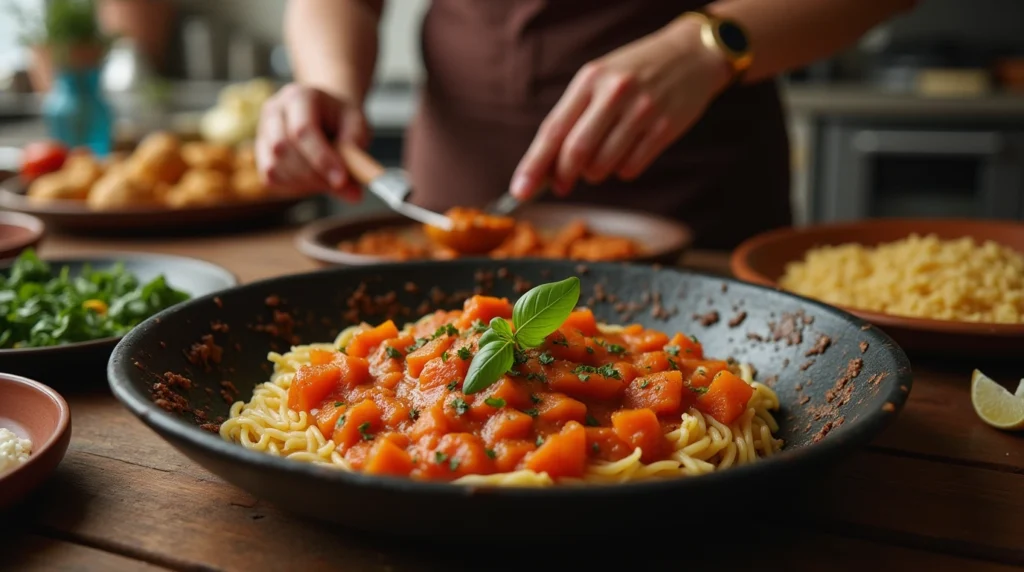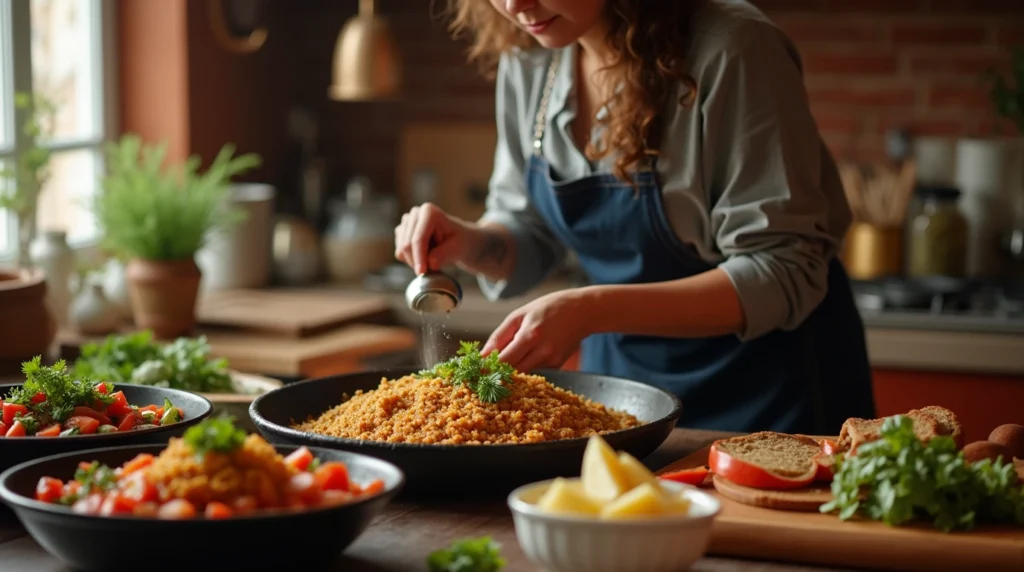Our Location
304 North Cardinal St.
Dorchester Center, MA 02124

Moroccan side dishes are more than just sides. They’re full of flavor and make any meal special. This guide shares five ways to bring Moroccan taste to your home. These dishes mix old traditions with new ideas, creating bold and balanced flavors.
Learn how Moroccan side dishes use spices like cumin and paprika. They also add preserved lemons and olives for extra depth. Each dish balances acidity, sweetness, and heat, making it perfect with main courses. Whether you’re roasting veggies or making couscous, these tips will make every bite authentic.
Traditional Moroccan cuisine focuses on balance, where each moroccan side dish is key. These dishes come from Morocco’s rich history, mixing Berber, Arab, and Mediterranean flavors. Every bite shares a tale of cultural exchange and shared meals.
Side dishes are at the heart of Moroccan gatherings and celebrations. They show Morocco’s strategic location between Africa, Europe, and the Middle East. Recipes are often passed down, keeping traditions alive like slow-cooking and layering spices. These dishes show the country’s love for welcoming guests, with ingredients like olives and preserved lemons.
From Chefchaouen’s herbs to Essaouira’s spices, each region’s side dish adds to the main course. A fresh salad can contrast a hearty tagine, while couscous soaks up meat sauces. Warm spiced nuts and cold yogurt dips also play with temperature and texture.
These elements transform simple ingredients into complex flavors. Understanding these basics is key to mastering Moroccan cooking, not just listing ingredients.
Moroccan vegetable side dishes get their flavor from a few key spices. These spices mix earthy, sweet, and smoky tastes. At the center is ras el hanout, a mix of 15–30 spices. Chefs say to use quality blends or make your own with cumin, coriander, and cinnamon.
Spice use varies by region. Coastal areas use more cumin and paprika. Mountain regions prefer ginger and caraway. Desert kitchens add cayenne for heat.
Toasting whole spices before grinding makes them smell better. This trick makes simple carrot or zucchini sides taste great.
Keep spices fresh by storing them in airtight containers away from light. Whole spices can last up to two years. For moroccan vegetable side dishes, start with small amounts. Spice ratios can change by ¼ teaspoon to avoid overpowering fresh ingredients.
Learning to mix sweet and savory turns simple veggies into amazing moroccan vegetables side dish dishes. Moroccan chefs use this trick to make dishes pop without adding too much. Three easy ways—caramelizing, roasting, and quick-pickling—show how to do it. Each method uses simple ingredients to create deep, rich flavors.
These simple steps lead to big flavors. Adjust the honey to your liking and try different spice mixes. The goal is to keep the sweetness in check, so it enhances the savory flavors.
Traditional Moroccan couscous side dish recipes need careful steaming to get the grains light and fluffy. Some use quick boxed couscous, but the real deal steams it three times. This method fluffs the grains between layers. Today, cooks can use a pot or steamer to mix tradition with ease.
It’s important to pick the right couscous size. Fine works well in stews, medium is good for salads, and coarse is best for textured dishes. To add flavor, cook the grains in chicken or vegetable broth instead of water. Adding sautéed onions, garlic, or fresh herbs during steaming also enhances taste.
Here are some tasty couscous side dish recipes to try:
Coastal areas often add flaked fish or shrimp, while inland dishes include dried apricots or almonds. A sprinkle of olive oil and flaky salt makes it even better. These couscous side dish recipes are easy to make and suit many diets, showing couscous’s flexibility.
Moroccan cuisine makes simple ingredients shine. Chickpeas are a great example. They become unforgettable with bold flavors and creative methods, showing that even basic items can delight everyone.
Warm spiced chickpeas with fresh herbs offer a unique texture. Dried chickpeas are creamier, but canned ones work too if rinsed and seasoned with cumin, paprika, and lemon. It’s a filling moroccan chickpea side dish or a light meal.
Fry chickpeas in flour and spices until they’re golden. A bit of preserved lemon adds a salty kick. These crispy bites are great with tagines or as snacks.
Make a tasty moroccan chickpea side dish by blending chickpeas with tahini, garlic, and harissa. Add cilantro or preserved lemon for a true Moroccan taste. Enjoy it with warm bread or grilled meats for a flavorful dip.
These recipes show how chickpeas fit into Moroccan cooking. They can be warm, crispy, or creamy. Each dish focuses on balance, like texture, heat, or acidity, to turn simple into sophisticated.
Eggplant turns into silky textures in these moroccan eggplant side dish recipes. The secret is in the technique. You need charred edges, the right spice mix, and keeping it moist. Here are three dishes that show how versatile aubergine is:
| Dish | Key Technique | Signature Flavor |
|---|---|---|
| Smoky Roasted Eggplant with Tahini | Charring under high heat | Umami tahini drizzle |
| Zaalouk | Slow-cooked with tomatoes | Spiced eggplant and garlic |
| Quick-Fried Eggplant with Harissa | High-heat frying | Harissa heat and crunch |
Roast eggplant over fire or broiler until the skin blisters. Scoop out the flesh and squeeze out excess liquid. This makes it dense. Then, mix it with tahini, lemon, and cumin. Serve with bread.
This stew uses roasted eggplant, tomatoes, and garlic. It’s cooked with cumin, paprika, and preserved lemon. Let it chill overnight for even more flavor. It’s a moroccan aubergine side dish like no other.
Cut eggplant into coins, salt them, and let them sit for 30 minutes. This removes bitterness. Fry them until golden, then toss with harissa and cilantro. Serve warm or at room temperature.
Pro tips: Pick firm eggplants with smooth skin. Keep leftovers in airtight containers for up to three days. Adjust spices to your liking—zaalouk can be smooth or chunky.
Preserved lemons and olives are key in moroccan side dishes. They bring a unique flavor that’s hard to find elsewhere. Their salty taste balances proteins and grains, making every bite perfect.
Preserved lemons are made by quartering lemons and adding salt and spices. They’re left to soak for weeks. The rind and pulp add a rich flavor to dishes like tagines or couscous. Chefs suggest chopping the rind for salads and using the pulp in stews.
Olives in Moroccan cooking come in different types:
Adding spices like cumin or paprika can make moroccan side dishes even better.
| Type | Flavor | Best Use |
|---|---|---|
| Green Olives | Bitter, earthy | Vegetable salads, grain bowls |
| Purple Olives | Raisin-like sweetness | Stuffed dishes, couscous toppings |
| Oil-Cured | Creamy, salty | Spreads, appetizer platters |
These preserved items were crucial in arid regions for food. They last long, making them essential for meals all year. Today, they’re must-haves for anyone making moroccan side dishes at home. For example, mix preserved lemon with olive oil and parsley for a quick couscous topping. Or blend olives with harissa and orange zest for a vibrant mezze plate.

Busy cooks can enjoy authentic flavors without spending hours in the kitchen. These easy moroccan side dishes are quick and simple, great for weeknight meals. They are no-cook, make-ahead, or one-pan wonders, blending tradition with convenience.
Save time with dishes that need no stove time:
Prep ahead for flavors that get better overnight:
Clean up fast with these all-in-one recipes:
| Category | Example Dish | Prep Time | Key Ingredients |
|---|---|---|---|
| No-Cook | Cucumber Salad | 10 mins | Cucumber, preserved lemon, mint |
| Make-Ahead | Harissa Yogurt | 15 mins + chill | Plain yogurt, harissa, garlic |
| One-Pan | Rainbow Veggie Roast | 25 mins | Vegetables, cumin, paprika |
These easy moroccan side dishes use common ingredients like preserved lemons and harissa. They pair well with tagines or grilled meats for a quick taste of Morocco. Adjust spices to your liking and store leftovers for up to three days.

Moroccan side dishes are more than just food—they bring a philosophy of balance and creativity to your table. By learning the five secrets shared here, you can make your meals more vibrant. These techniques turn simple ingredients into unforgettable dishes.
Start by stocking your pantry with essentials like ras el hanout, preserved lemons, and harissa. This lets you cook freely. Begin with small steps, like adding a jar of olives or a mix of cumin and paprika. These can lead to many different dishes.
Adding Moroccan flavors to your meals is easy. Start with simple recipes like spiced chickpeas or pickled carrots. Then, you can add more complex flavors. Moroccan cooking is all about being flexible and trying new things.
Moroccan side dishes are about keeping things simple and sharing with others. A dish of couscous or a salad with preserved lemons can start great conversations. They help bring different cultures together through food. By using these techniques, you can make your meals more exciting and global, even on busy days.

In Morocco, you’ll find favorites like couscous and zaalouk, an eggplant spread. Roasted veggies and salads with chickpeas and olives are also loved. These dishes show off the unique tastes of Moroccan spices.
For quick Moroccan sides, try no-cook salads or pre-roasted veggies with Moroccan spices. These options are ready in under 30 minutes.
Key spices for Moroccan sides are cumin, coriander, cinnamon, and ras el hanout. These spices add distinct flavors to veggies and chickpeas.
A tasty Moroccan chickpea dish is a spiced chickpea salad. It mixes cooked chickpeas with parsley, lemon, and spices for a bright taste.
For a Moroccan eggplant dish, try zaalouk. It’s a warm eggplant spread with garlic, cumin, and tomatoes. It goes well with many meals.
Couscous is steamed multiple times to get fluffy. It’s flavored with broth and spices for a savory side.
Preserved lemons add a unique flavor. Use them in salads, couscous, or vegetable tagines for an authentic taste.
Yes, dishes like zaalouk and marinated olives get better with time. Storing and reheating them right can make them even tastier.
Quick pickles include carrots, radishes, and preserved lemons. They add a tangy touch to richer dishes and are easy to make.
There are no reviews yet. Be the first one to write one.